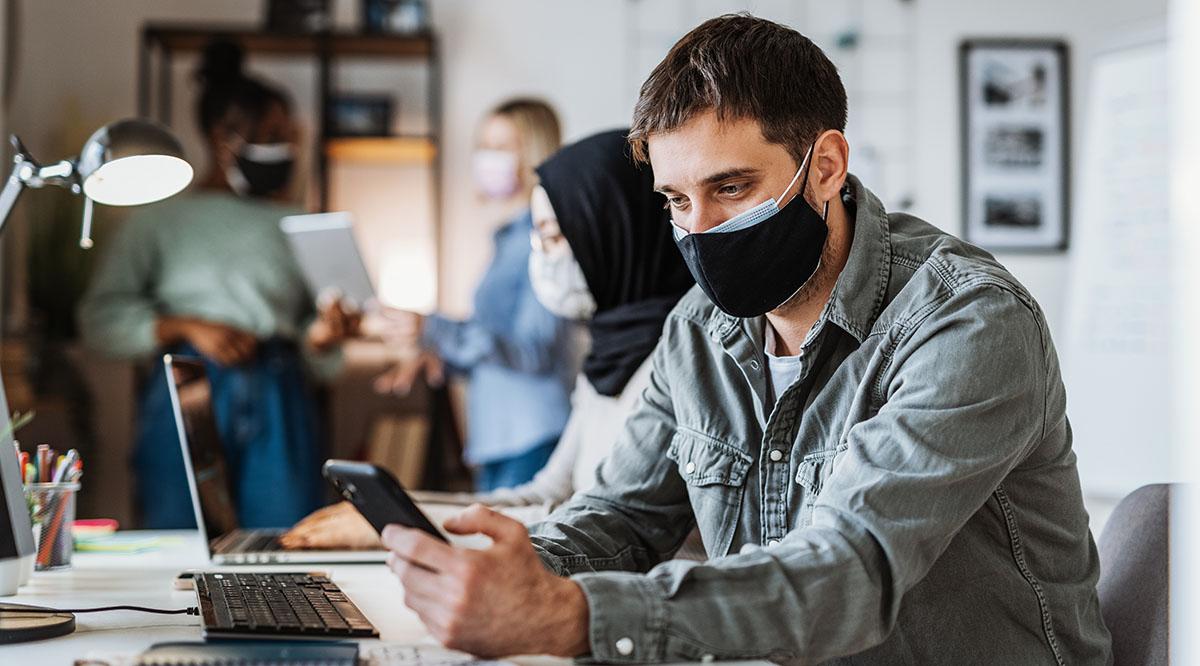When the Centers for Disease Control and Prevention (CDC) said on May 13 that people who were fully vaccinated against COVID-19 could go into most public places without a mask, it relied heavily on data that had been collected about the then-dominant alpha variant. The agency pointed to studies showing that fully vaccinated people rarely became infected and were unlikely to transmit the virus to others. COVID-19 cases had plummeted since mid-April and vaccinations were ramping up.
But the country was in a different situation when the CDC walked back its recommendations on July 27. Vaccinations have leveled off with just under 50% of the total U.S. population being fully vaccinated, and the highly contagious delta variant is driving another surge in cases. The agency officially recommended that fully vaccinated people living in communities with substantial-to-high transmission rates (defined as 50 or more new cases per 100,000 people in the past seven days) should wear masks when in public, indoor places.
Still, experts have reiterated that the COVID-19 vaccines available in the United States are highly effective at protecting against the coronavirus, including the delta variant.
“So far, it really looks like most of the hospitalizations and virtually all of the deaths that we are seeing are in unvaccinated people,” says Chris Beyrer, MD, MPH, the Desmond M. Tutu professor of public health and human rights in the Department of Epidemiology at the Johns Hopkins Bloomberg School of Public Health.
So, if the vaccines work so well, why should vaccinated people go back to wearing masks?
Vaccinated people may be able to spread the delta variant
According to the CDC’s amended guidance, new data suggest that fully vaccinated people infected with the delta variant may be able to transmit the virus to others, even if they don’t get seriously ill themselves.
“The data are clear — the most recent data — that when a person gets infected who has been vaccinated, namely a breakthrough infection, and they get infected with the delta variant, that the level of virus in their nasopharynx [the upper throat behind the nose] is about 1,000 times higher than with the alpha variant,” Anthony Fauci, MD, the top U.S. infectious disease expert, explained on MSNBC on July 28. “And it has been well documented that even though it’s a rare occurrence, those individuals can and have transmitted the virus to uninfected individuals.”
“People who are infected shed a lot more virus. That makes it harder for the masks to work and means people should be wearing high-performance masks.”
Linsey Marr, PhD
Charles P. Lunford professor in engineering and professor of civil and environmental engineering in the College of Engineering at Virginia Tech in Blacksburg
Various studies have shown that the delta variant is significantly more transmissible than the original coronavirus. One preprint study in China found that it replicates sooner and faster, making it much easier to spread. The CDC also released data on Friday from an outbreak in Massachusetts that stemmed from summer events in early July. Of the 469 people who tested positive for COVID-19, 74% were fully vaccinated. Seventy-nine percent of the breakthrough infections were symptomatic and four vaccinated people were hospitalized.
This makes high-quality masks all the more essential, says Linsey Marr, PhD, the Charles P. Lunford professor in engineering and a professor of civil and environmental engineering at Virginia Tech in Blacksburg.
“People who are infected shed a lot more virus,” she notes. “That makes it harder for the masks to work and means people should be wearing high-performance masks.”
According to Marr, N95 or KF94 masks are ideal if they’re available. Otherwise, using two masks — a surgical mask with a snugly fit cloth mask over it — is acceptable. Loose-fitting masks that leave gaps around the face, like surgical masks alone, are far less effective and are like having a hole in your mask, she added.
But when masks are worn appropriately, they’re extremely effective at protecting both the wearer and others.
“There was so much data generated about masks [last year],” says Krystal Pollitt, PhD, an assistant professor of epidemiology and chemical and environmental engineering at the Yale School of Engineering and Applied Science. “All of the same parameters for increasing the effectiveness of masks then are very much valid now.”
Pollitt explains that people can consider several factors to determine their risk of being infected, including the rate of vaccination and infection in their locality and the crowdedness, ventilation, and physical distancing possible at the venue. While outdoor activities are far safer than indoor ones, she adds that people should still be mindful of outdoor spaces that are crowded and avoid close, maskless contact with people who may be unvaccinated.
Children under 12 and people with compromised immune systems are vulnerable to infection
Unvaccinated adults are particularly vulnerable to the delta variant and are driving surges of cases and increasing hospitalizations in parts of the country, particularly in areas where vaccination rates are low. However, they are not the only ones at risk.
Although kids have made up a small share of infections and severe outcomes throughout the pandemic, the number of infected children has been rising in recent weeks, according to a report from the American Academy of Pediatrics. The Food and Drug Administration has not yet authorized any COVID-19 vaccines for children under the age of 12, making them potentially susceptible to infection. The CDC’s most recent guidance calls for universal indoor masking at K-12 schools.
“Multigenerational families need to think about this [risk]. If there are elderly people, seniors, immunocompromised people [in the home], then everybody needs to be more careful.”
Chris Beyrer, MD
Desmond M. Tutu professor of public health and human rights in the Department of Epidemiology at the Johns Hopkins Bloomberg School of Public Health
Also, people who have weaker immune systems — whether due to age or a medical condition or because they are on immunosuppressant drugs for an organ transplant or autoimmune disorder — could be vulnerable to infection, even if they have been fully vaccinated.
“There is some evidence those folks might need [a booster shot],” Beyrer says.
Israel, which was an early global leader in vaccinations, has authorized a third dose of the Pfizer COVID-19 vaccine for residents over the age of 60 in response to some evidence that the immunity from the vaccine wanes more quickly in older people, the Washington Post reported on July 29.
“Multigenerational families need to think about this [risk],” Beyrer explains. “If there are elderly people, seniors, immunocompromised people [in the home], then everybody needs to be more careful.”
The CDC currently recommends that people who are at increased risk for severe disease from COVID-19 — including older adults, people with diabetes, people who are overweight, and people with heart conditions — as well as people living with an at-risk person should consider wearing masks in indoor, public places regardless of the levels of community spread.
From a psychological standpoint, we should have never stopped masking
“In general, psychologically, some people don’t do well with change and ambiguity,” says David Abrams, PhD, a professor of social and behavioral sciences at the School of Global Public Health at New York University.
While Abrams acknowledges that scientific data might have supported the CDC’s decision to relax masking guidance for vaccinated people in May, he thinks the public perception of the guidance is that it is inconsistent and may cause people to dig in their heels in protest.
“The confusion that’s been there from the start, coupled with changing rules that appear to contradict one another, upsets people,” Abrams says. “I understand that the CDC has tried to be reasonable and it’s come back to bite us.”
He believes that it could have been more effective for government leaders to encourage people to double-down on public health measures to stop the spread of the virus, not only by getting vaccinated but also by continuing to wear masks and maintain physical distance. Furthermore, federal mandates with clear consequences — such as masks being required on planes — tend to encourage safer behavior.
Abrams worries that the CDC’s latest guidance, which changes depending on the current level of documented infection rate in a locality at a given time, will only add to the confusion.
“Trying to use the science at that micro level to make it a little easier for people may well backfire,” he says. “Until the virus is completely under control and not spreading, everybody should wear a mask and more people should be vaccinated — both medical and public health measures work best in concert.”
He compared the public health response to the pandemic to running an Olympic marathon.
“If you’re a marathon runner and you’re in the lead and doing really well, you don’t slow down when you get to the last mile. This is the most important part,” he explains. “We’re doing well, but we are nowhere near crossing the finish line yet.”

